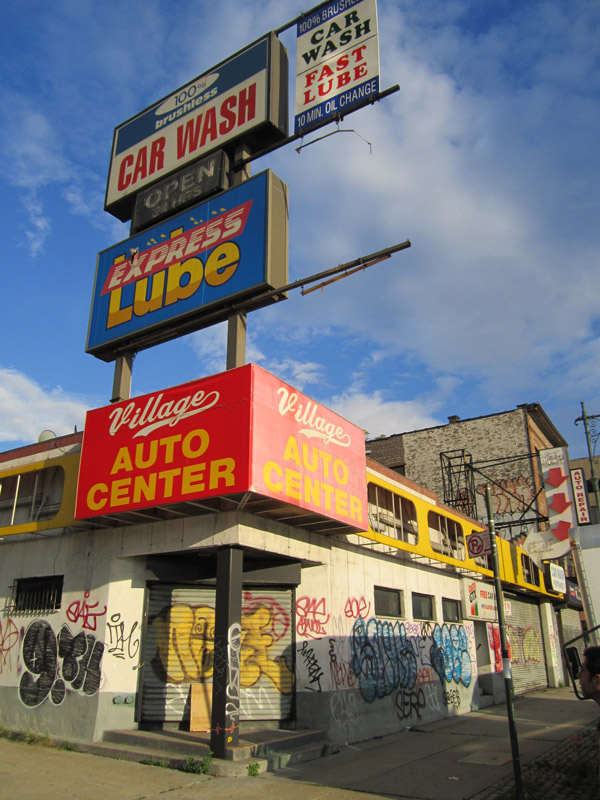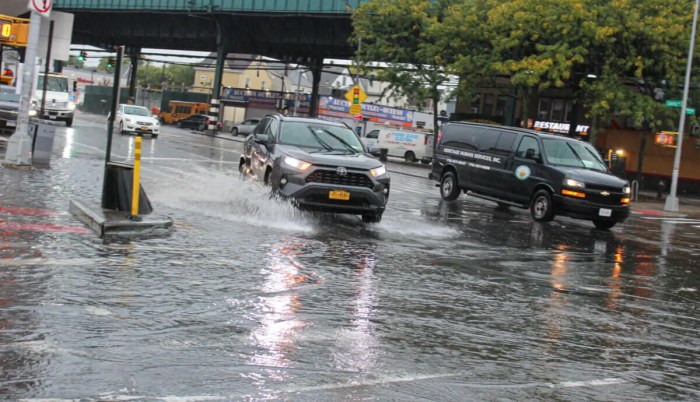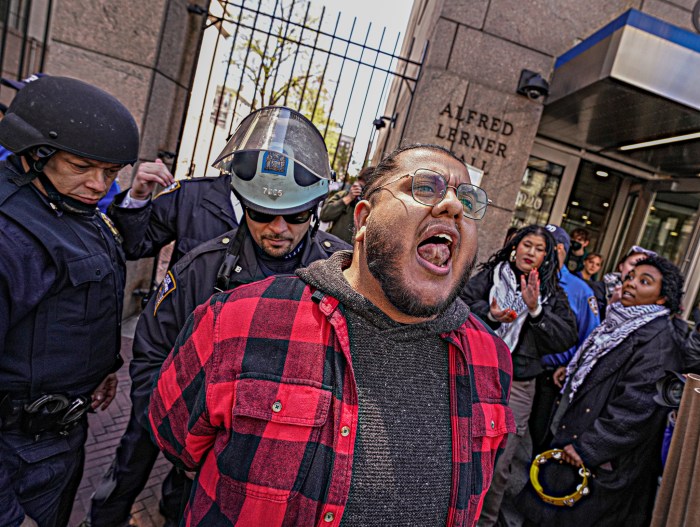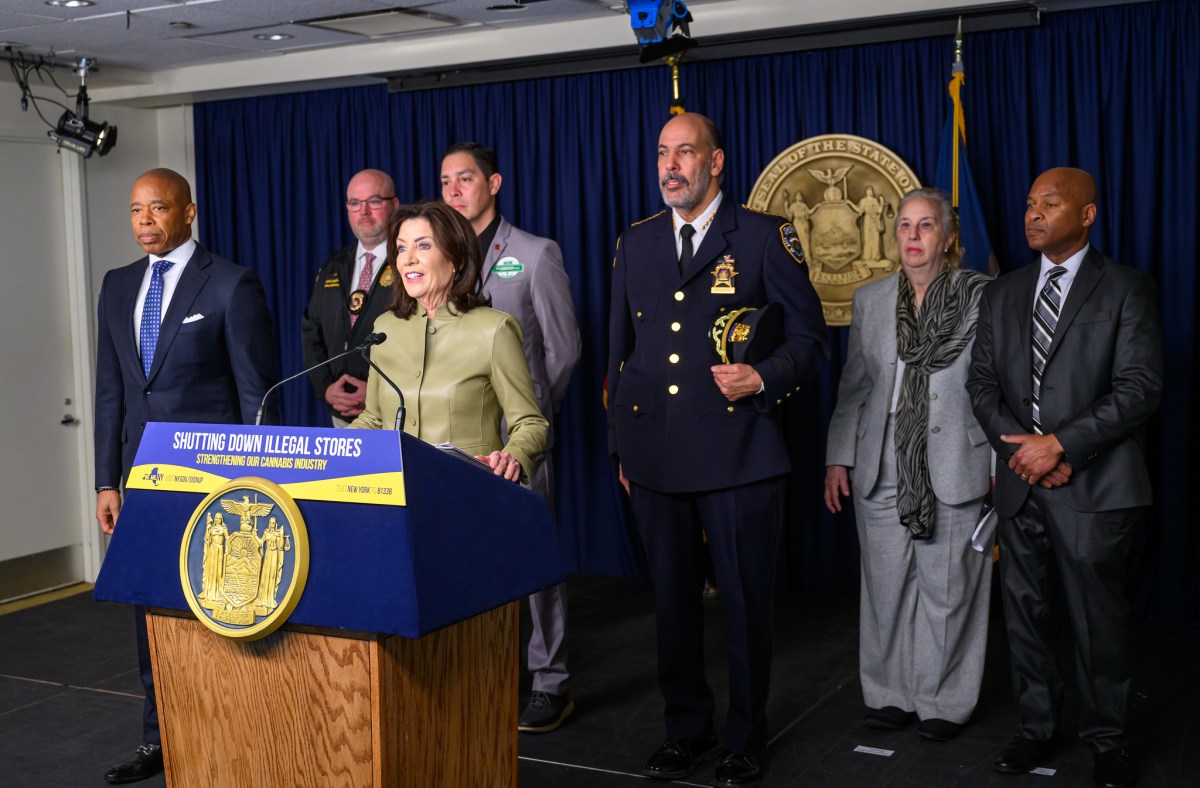
This development-ready property on West St. between Clarkson and Leroy Sts. could possibly benefit from an air rights transfer from the Hudson River Park.
BY LINCOLN ANDERSON | As the State Legislature’s session drew to a close last week, a sweeping bill to modify the Hudson River Park Act, which would, most notably, allow the park to transfer its unused air rights, was quietly passed by both the Assembly and the State Senate.
“Radio silence” was how one stunned park watchdog described how the bill suddenly popped up in the session’s final days, seemingly without anyone — other than local affected politicians, the Hudson River Park Trust and, no doubt, key stakeholders — having heard a peep about it until then.
The bill was approved by the Assembly 96-5 last Thursday.
Then, after a marathon session that began Friday and turned into an all-nighter, the bill finally came up before the Senate on Saturday morning, and around 5 a.m. was passed unanimously 57-0.
The governor’s signature is still required, though his approval is expected.
The bill’s sponsors were Richard Gottfried and Deborah Glick in the Assembly. In the Senate, the sponsor was listed simply as “Rules Committee.” In other words, there was no sponsoring senator.
Most notably, approval of the bill will allow the Hudson River Park to sell its unused air rights for development up to one block inland of the West Side Highway — with the proceeds from Pier 40’s air rights specifically earmarked for sorely needed repairs to the West Houston St. pier’s roof deck and support pilings.
The bill also extends the lease terms for commercial uses in the park to 49 years, and in some cases, for larger developments, up to 99 years. However, on Pier 40, the lease term remains 30 years. Potential Pier 40 developers have, in the past, argued their plans wouldn’t work without a longer lease.
Also, under the new bill, the city is required to give Pier 76, at West 36th Street, fully to the Trust, once the tow pound is removed from the pier. Fifty percent of this pier’s footprint will be designated for park use, with the remainder of the pier slated for park / commercial use. The Trust would get all the revenue generated by the pier.
In addition, the bill calls for the imposition of a surcharge of up to $2 on tickets for all commercial vessels (entertainment, sightseeing, day or dinner cruises) that embark or disembark within the park, with this tax paid directly to the Trust.
Floating heliport
Under the modification to the park act, the current West 30th Street Heliport also will be moved off the upland part of the park and out onto a one-story heliport terminal on a floating structure — possibly, a barge or pontoons — in the Hudson River somewhere between West 29th and 32nd Streets. No additional structures can be built on the landing pad. Though still located in the park, which extends out to the pier-head line, this floating landing pad will move the noisy and noxious heliport farther away from park users and the community.
Furthermore, the bill expands allowable revenue-generating uses at the park’s designated commercial piers to include restaurants, media and film studio facilities, commercial amusements — such as carousels — performing arts, schools and educational facilities.
Finally, the bill allows Pier 54, at West 13th Street, the park’s main event pier, to be rebuilt wider than its original footprint.
Neither Glick nor Gottfried — whose districts each include part of the park — got everything they wanted in the bill. The bill doesn’t allow things at Pier 76 that Gottfried favored, such as hotel and residential use and possibly a large Ferris wheel. It doesn’t permit something Glick wanted at Pier 40, commercial office use, which is needed to allow Douglas Durst’s adaptive reuse proposal to convert the pier’s three-story shed structure into a high-tech office campus.
The area’s local youth sports leagues last year put on a major push to change the park’s legislation to allow residential use on or next to Pier 40 — feeling it was the best way to ensure funding to fix up the crumbling “sports pier.” However, lack of political support sunk that idea.
‘Certainly a compromise’
“The bill is certainly a compromise,” Gottfried told our sister publication, The Villager. “It does several important things for the financial viability of the park and for the quality of the park. However, most of the provisions relating particularly to Pier 40 or Pier 76 were deleted [from the bill’s final version]. We will hopefully take up issues relating to those piers next year. I felt it was better to do that than enact some very inadequate provisions that would then be very difficult to change in the future.
“The provision allowing the Trust to sell unused development rights of the park to adjoining properties can potentially provide considerable revenue for the park,” Gottfried said.
The heliport was slated to vacate the park in two years. But Gottfried said it’s being kept, albeit out in the water, because “there is a strong desire for a heliport on the West Side — for emergency transportation, and, as you can imagine, there are some people with influence in our society who think getting in and out of Manhattan by helicopter is very important to them.”
For State Senator Brad Hoylman, satisfaction at the bill’s passage was tempered by what he criticized as a lack of transparency in the process.
“The amended Hudson River Park Act isn’t perfect,” Hoylman said, “but it provides critical new sources of revenue to facilitate the park’s completion, operation and maintenance, and on balance it’s good for my constituents, many of whom are among the millions of people who visit Hudson River Park each year.”
‘Lack of transparency’
“That said,” Hoylman continued, “I am disappointed by some of the provisions, and particularly by the lack of transparency or opportunity for public consultation on major portions of the bill.”
It was actually Hoylman, the freshman senator, who sent The Villager a draft of the bill on Tues., June 18 — the newspaper’s first notification that the legislative changes were being proposed.
Hoylman added there was a lot of “momentum” behind the bill, and that he worked to achieve what he could, including ensuring that the air rights transfers would undergo public review.
“I am particularly happy,” Hoylman added, “that the legislation facilitates the preservation of Pier 40 and its sports fields and ensures the entirety of Pier 76 will be incorporated into the park.”
In a statement, Glick hailed the legislation for keeping inappropriate private development out of the park, while at the same time providing the Trust with some new financial mechanisms to maintain the park’s upkeep.
Preserving Pier 40
“I am pleased that this legislation strikes a balance between financial support and protecting public space,” she said. “In particular, I am glad that any sale of the air rights from Pier 40 will directly be used to repair and secure Pier 40’s infrastructure — thus ensuring that playing fields utilized by children and adults will continue to exist for generations.”
The idea for a surcharge on commercial vessels using the park was originally Glick’s, and she claimed it could bring in $1.5 million for the Trust annually.
Before the vote on the legislation, Madelyn Wils, the Trust’s president, sent out a letter to politicians and park advocates stating, in part, “Last night the Assembly and Senate each introduced a bill to amend the Hudson River Park Act, enabling legislation in line with many items discussed and introduced by the Hudson River Park Task Force over the last year and a half. … It provides many significant and important additional rights [for the Trust], plus some language clarifications that will allow us to improve our bottom line and help support the park’s viability into the future.”
Widening Pier 54
Wils also noted that authorizing Pier 54 to be built beyond its historic footprint “will allow for securing [a] significant donation to be used toward development of Pier 54 as a world-class public programming space.”
It’s been rumored that Barry Diller, husband of fashion icon Diane von Furstenberg, will make a multimillion-dollar matching grant toward Pier 54’s renovation. Widening the pier would make it easier and safer for people to enter and exit it at big public events, according to the Trust.
However, while politicians are hailing the Legislature’s latest modifications to the park act, the Village’s leading preservationist, for one, is up in arms. Andrew Berman, executive director of the Greenwich Village Society for Historic Preservation, said the public should have been consulted about the bill’s most dramatic change — allowing the Trust to transfer the park’s unused development rights one block inland.
Pier 40 alone has massive air rights, the preservationist added, noting, “I’ve been told there’s a couple of hundred thousand square feet there.”
No air rights study?
The preservationist said he is, first of all, concerned that the bill was passed so quickly, but also that there doesn’t seem to be any study about the air rights transfers and their potential effect on the Lower West Side.
“I’ve asked people, and no one is aware of it,” he said of whether any formal study exists.
Asked for a potential site that could be impacted, he said, “The ‘car wash / gentlemen’s club block’ north of the St. John’s Building [between Clarkson and Leroy Sts.] — basically, sites that are not landmarked and don’t have contextual zoning that would limit what could be squeezed in there.
“Even blocks that are currently developed — if they could access thousands of square feet of development rights, they could be developed further as a result,” he said.
A pressing question, Berman said, is whether — now that the state has approved the air rights transfers — the city will still have a review role under the ULURP (Uniform Land Use Review Procedure) or even by a special permit through the City Planning Commission.
‘Frankly, quite disturbing’
“The speed with which this moved — and with lack of consultation and lack of information about its impacts — is frankly quite disturbing,” Berman continued. “There should have been hearings. There should have been consultations with affected communities. There should have been a very clear analysis of the scope of development that this could allow and what the impact could be.
“We understand that there is an imperative to find new ways to find revenue for the park,” Berman added, “but this was so sudden and dramatic.”
We asked Gottfried how much income the air rights transfers could potentially generate for the park and if there had been a financial study. Gottfried said he didn’t think a full study had been done, and also that he couldn’t really give a dollar amount since development is always “speculative,” based on the real estate market.
In a telephone interview on Monday, Glick said, “Like all negotiated bills, there are compromises that were made on all sides.”
Trust’s relentless pressure
“I’m totally thrilled that we prevented the Trust from permitting any residential or hotel use in the park,” she said. “That was something that they kept pressing for right until the end. And they wanted long-term leases at Pier 40 — they didn’t get that.
“I had a goal, and the goal was to preserve Pier 40 for the playing fields and to prevent major hotel and residential development in the park — and these were accomplished.”
As for whether the air rights transfers from the park to east of the highway would undergo the city’s ULURP public review, Glick noted the bill says, the transfers would be allowed, “to the extent…permitted under local zoning ordinances,” so, by her understanding, that would seem to indicate ULURP would apply.
Glick dubious on air rights
In fact, she remarked, of the air rights transfer provision, “I would have rather not seen it done, but I wasn’t the only one in the Assembly majority.”
She wouldn’t clarify if she was referring only to Gottfried, or perhaps also to Assembly Speaker Sheldon Silver.
In a statement on the Legislature’s passage of the bill, Silver said, “Parks and ball fields are such precious commodities in Manhattan and this agreement enables us to maintain and expand those resources to thousands of local residents, workers and visitors. I applaud the many community stakeholders who have worked with us to arrive at this landmark agreement that ensures this great park will continue to serve us for many decades to come.”
As for why there were no public hearings on the park act changes, Glick said, “We don’t have hearings on everything. We didn’t have hearings on speed cameras. It’s not required. And the circumstances were what they were: The city pushed hard, the Trust pushed hard — and yet we were successful in blocking the inappropriate development that they were desperate to include.”
Says Glick was Missing in action
Arthur Schwartz, vice chairperson of the Hudson River Park Advisory Council, lost no time in criticizing his frequent political foe over the lack of public review of the changes to the park act.
“We had three or four public hearings on the proposal to build residential housing on Pier 40,” Schwartz said, referring to hearings last year. “I mean, where is this Deborah who is rallying the troops? Where did she go?”
Schwartz said Trust President Wils was at the advisory council’s meeting this Monday and discussed the air rights transfer provision. Basically, there are 1.6 million square feet of unused air rights in the park available for sale right now, according to Wils. The park’s upland portion — the part on land — has no air rights. It’s only the piers designated for commercial use that have air rights, namely, the Chelsea Piers, and Piers 40, 57, 76, 81, 83 and 98. Once piers are designated as public space they apparently lose their air rights.
Schwartz said the bill should have more restrictions on the development rights transfers, such as how much F.A.R. (floor air ratio) can be transferred to certain sites and height caps on development.
“It was not well thought-out and there should have been a lot of public comment on it,” he said.
Indeed, the reason hearings were held on the Pier 40 residential idea last year was largely because Glick demanded them.
‘It’s great for Pier 40’
However, Tobi Bergman, president of P3, a Pier 40-based youth sports organization, saw the bill’s passage as a win-win. The 15-acre pier has become the Lower West Side’s equivalent to Central Park and a youth sports mecca, due to its huge courtyard artificial-turf sports field.
“I was happy to see that Pier 40 remains protected from the worst kind of development, large-scale retail and entertainment projects, because the lease term there will remain 30 years,” Bergman said.
“The best new opportunity will be the potential sale of air rights, creating the possibility of income for Pier 40 without new buildings at the pier. The ability to sell air rights may create the possibility of removing parts of the existing mammoth [pier shed] structure to open the park to the river.”
Bergman led the local youth leagues coalition, Pier 40 Champions, in their failed push last year for a pair of residential towers to be built next to the pier, to provide revenue to fix up and maintain Pier 40.
As for the public having been kept in the dark until the bill was O.K.’d last week, Bergman downplayed it.
“Everyone loves transparency,” he said, “but the legislative process isn’t usually that way, and in the end we need to rely on the people we elect to legislate, for better or for worse.”
Fortress / 40 connection
Another eyebrow-raiser about the air rights transfers concerns Pier 40 and Michael Novogratz, the new chairperson of Friends of Hudson River Park, the park’s main private fundraising arm. Novogratz formerly sat on the Trust’s board of directors.
Earlier this year, it was reported that Fortress Investment Group, which is headed by hedge-fund investor Novogratz, had purchased the majority share in the St. John’s Building, located directly across the highway from Pier 40.
When queried about this by The Villager in February during a sit-down with Wils, Novogratz said he is more on the investment side of the company — not its real estate division — and he and Wils shared a laugh, saying that he didn’t even know there had been a story about it until Wils told him.

















